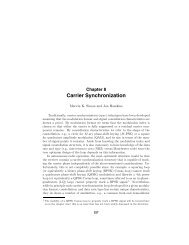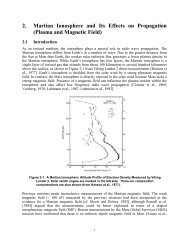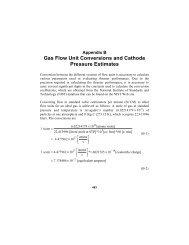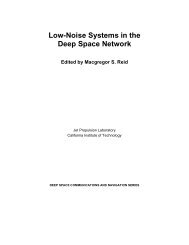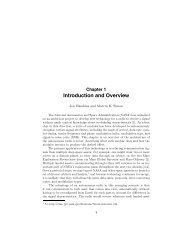Propagation Effects Handbook for Satellite Systems - DESCANSO ...
Propagation Effects Handbook for Satellite Systems - DESCANSO ...
Propagation Effects Handbook for Satellite Systems - DESCANSO ...
Create successful ePaper yourself
Turn your PDF publications into a flip-book with our unique Google optimized e-Paper software.
equal. The fade distributions resulting from the Ohio State<br />
University ATS-6 30 GHz beacon measurements (Devasirvatham and<br />
Hedge-1977) indicate that this log-normal assumption is valid <strong>for</strong><br />
elevation angles above approximately 2°. A similar observation was<br />
made -concerning the 7.3 GHz fade distribution above 4° elevation<br />
angle observed by McCormick and Maynard (1972).<br />
A fade distribution may now be produced using this assumption of<br />
linearity. Referring to Figure 6.5-13, it was noted that the point<br />
at which the received signal level is R dB represents the mean<br />
signal level. For a normal distribution, ,the mean is plotted at the<br />
50% time abscissa exceeded point, indicated by 1 in the figure. One<br />
standard deviation to the right of the mean on a normal distribution<br />
occurs at the 15.9% time abscissa exceeded level. It may be easily<br />
shown that the standard deviation of received signal level,<br />
expressed in dB and denoted OvdB~ may be written in terms of the<br />
signal variances S20 This point~ @@, to the right of R, is denoted<br />
by 2 in the figure. A straight line drawn between points 1 and 2<br />
now approximately represents the fade distribution, referenced to<br />
the mean signal level in the absence of turbulence induced<br />
fluctuations. This distribution was based on small fluctuation<br />
arguments and should be employed as a lower bound when estimating a<br />
particular fade distribution.<br />
Deviation of this fade distribution from the expected <strong>for</strong>m will<br />
occur at small time percentages. Additional fading due to<br />
precipitation, abnormal refraction, or inversions in the atmosphere<br />
will cause greater fade depths <strong>for</strong> the small time percentages.<br />
However, the turbulence effects, which are always present, are still<br />
dominant <strong>for</strong> larger time percentages. For high elevation angles,<br />
i.e., short path lengths, Sz will be very small and the line drawn<br />
through points 1 and 2 will be virtually vertical.<br />
However, the precipitation effects at the lower percentages will<br />
still be present <strong>for</strong> short path length cases and will become the<br />
dominant feature of the fade distribution.<br />
6-97





